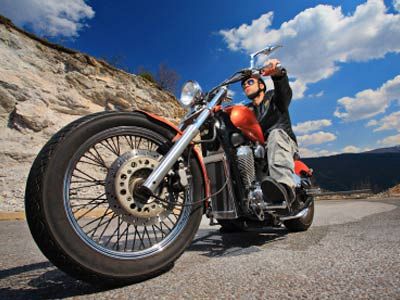You know that you get the best braking performance by getting as close to skidding as possible without skidding. This is called 'threshold braking' by most riders (though a much healthier definition would be decelerating at any rate higher than you would if skidding). You also know that if you skid the front tire you are almost certainly going to crash, at least if you are not traveling in a straight line. So clearly practicing in an effort to learn how to achieve the best possible braking performance involves some danger and should not be done casually or by riders who are new to their bikes.
Learning threshold braking needs to be done with great care.
It doesn't matter if you are traveling at 60 MPH or 30 MPH, you can threshold brake. So it makes no sense to practice this skill at more than 30 MPH. Further, it makes no sense to try to learn threshold braking while also using both brakes. You learn this skill using ONLY the front brake. Once it is mastered you can then move on to learning how to use the rear brake at the same time.
NOTE: If you bike can do a stoppie (like most sport bikes), then if the Coefficient of Friction between your tires and the roadway surface is high enough you CANNOT threshold brake - that is, if the Coefficient of Friction is high enough, then you will do a stoppie before reaching the point where the front tire will skid.
Let me make a few points here that you should UNDERSTAND before you begin this kind of practice:
- A tire skids when you attempt to decelerate (or accelerate) it at a rate greater than the Coefficient of Friction available.
- The Coefficient of Friction between your tire and concrete is USUALLY higher than that of asphalt.
- The TEXTURE of the roadway changes the Coefficient of Friction (i.e., Rougher texture = higher CofF). In other words, you CANNOT stop as quickly on smooth concrete as you can on highway concrete.
- The MOISTURE content of the roadway changes the Coefficient of Friction.
What all of that means is that you CANNOT rely only on muscle memory to acquire this skill. That is, the 'feel' of the braking effort is not enough feedback to let you know that you are close to skidding. Fortunately, there is another form of feedback available to you - the sound of the tire as it gets close to skidding.
You need to ease into the threshold zone (meaning you use small increments of added braking pressure on the front brake lever) until you can actually hear the front tire begin to 'sing' to you as imminent traction loss occurs. NO FURTHER than that.
Obviously you only practice this skill while vertical and traveling in a straight line so that if you exceed that threshold and the tire begins to actually skid you can release the brake lever and recover. The entire purpose of practicing this is to learn to feel and hear when you are approaching the threshold.
While the front tire is 'singing' it is leaving a light 'skid mark'. It will not be a dashed line. It will be rather faint, not dark.
A dashed skid mark can result from the use of ABS. It, too, uses threshold braking but instead of holding the braking pressure as close to skidding as possible it releases then reapplies the brake causing the dashed 'imminent skid mark'










24
Comment